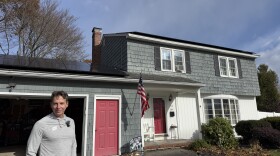Every other Friday on Morning Edition NHPR’s Sam Evans-Brown tracks down answers to questions about the environment and outdoors for our listeners in a segment we call “Ask Sam.”
Kenny, calling from his van, asks: “I’m wondering if, like I saw in a TED talk, if we could spray chalk into the atmosphere to reflect sunlight to solve global warming?”
Good gravy, Kenny! Usually we just talk about fall foliage and fireflies here. Couldn’t we have started ramping up into the controversial topics a little more slowly? Hokay. Let’s see if we can get through this in fewer than 6,500 words.
The TED talk in question is by a gentleman named Danny Hillis who is an inventor and computer scientist and notably not a climate scientist. It was controversial enough that before he even left the stage, the organizer invited up an actual climate scientist named Kate Marvel to respond to the idea (she told Danny, “You terrify me”) which you can see on the TED archive.
What this question refers to is albedo: the ability of things on earth to reflect the sun’s radiation back out into space. Specifically we’re referring to the reflectiveness of tiny particles suspended way up higher than the clouds, in the stratosphere.
We’ve known about the ability of such tiny particles to cool the globe for a long time. During the industrial revolution we released sulphate aerosols from factories and power plants, and while the greenhouse gases from those power plants were warming the climate, that warming effect was overwhelmed by the cooling effect of the aerosols.
So one of the perverse effects of the Clean Air Act (which, by-the-by, is also estimated to have saved millions of lives) was that it accelerated warming by reducing the number of tiny floaty particles in the atmosphere. The same is possibly true of the warming slow-down in the early 2000s: it could have been caused by aerosols from rapid industrialization in China.
But the real smoking gun for the ability of aerosols to cool our climate is volcanic eruptions.
“The last one we could observe was the Mount Pinotubo volcano in 1991… we actually saw cooling of the earth’s surface,” says Simone Tilmes, an atmospheric chemist with the National Center for Atmospheric Research in Boulder, Colorado.

The modern debate over whether we should consider so-called “solar radiation management” was kicked off when an atmospheric chemist who had won the Nobel Prize wrote an essay in 2006 suggesting we may have to. For his TED talk, Danny Hillis cribbed the idea of using “chalk” rather than sulfates from an experiment that Harvard is running that will release small amounts of calcium carbonate and measure the effect. In fact, one of the participants in this study, David Keith of Harvard, has his own — older, but much more well-informed — TED talk on the subject of geoengineering.
So to answer the strict question of can we “solve global warming” by shooting stuff up into the stratosphere? The straightforward answer to that question is yes, and as I laid out above, we have known about this for a long time. Hell, President Johnson’s Science Advisory Committee alerted him to the possibility in 1965.
But even so, there are a million reasons why people are wary of this idea, so let me just rattle some of them off, here.
Moral Hazard: The traditional response from the environmental movement to the proposal of geoengineering is that if we know that we can be bailed out by geoengineering, we will never do the hard work to reduce greenhouse gas emissions in the first place. But a key assumption of this argument is that a geoengineered world would be a worse world than one in which we deal with climate change by cutting carbon. So, on to the other caveats.
Pollution: If we use sulphate aerosols to achieve this effect, they themselves are a pollutant. When they come back down they are bad for your lungs, they were a major component of acid rain, and they combine with water vapor to degrade the ozone layer. (This is probably why the Harvard crew is trying calcium carbonate instead.)
Ocean Acidification: More CO2 in the atmosphere is also putting more CO2 into the oceans, which makes the water more acidic which could lead to the collapse of ocean life.
Global Rainfall: Putting aerosols up into the atmosphere could change global rainfall patterns, which could disrupt the monsoons and other rain patterns that agriculture depends on.
Once We Start, We Can’t Stop: If we were to start spraying aerosols we would have to keep doing it indefinitely until we actually reduce atmospheric greenhouse gases enough to stabilize the climate, because if we keep increasing emissions and then stop with the geoengineering the climate might change rapidly and catastrophically.
But even so, there are still a fair amount of climate scientists who know about all of these drawbacks, but are so freaked out by climate change that they say we might need this tool in our toolbelt. Which is why folks like Simone Tilmes believe we can’t stop asking questions about it. “Well, I would say what I really think we need is research on this technology,” she says.
It seems to me the one spot where I think there is something close to consensus about geoengineering among climate scientists is that we don’t know enough about it.
WAIT NO! That’s not my final take-away. My final point is WATCH OUT FOR TED TALKS. They’re very glossy, very shiny, and they seem so authoritative, but what they are at their core is one individual’s trying to convince you of something, and nothing more.
If you’d like to submit a question you can record it as a voice memo on your smart phone and send it to oustidein@nhpr.org, OR call our hotline, 1-844-GO-OTTER (1-844-466-8837) and leave a message.








